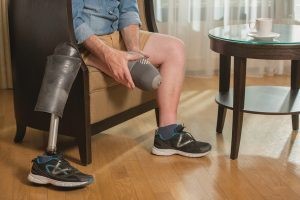1. What is suspension?
Suspension is the manner in which your prosthesis is connected to your residual limb. A suspension system is also referred to as a hanging system. It is important that your suspension system is a good match for your lifestyle, preferences and needs. This makes it essential that your suspension system:
- Fits your activity level
- Keeps your residual limb healthy
- Is comfortable
- Offers a sense of safety in every step
Always make sure to achieve the right balance between convenience and performance. If, for example, being able to put your prosthesis on and off quickly is very important to you, you may have to forfeit some control. This decision should always be based on your personal preferences and specific needs.
Proprioception
Proprioception is an important term for all those with an amputation: it means awareness of the movement and position of the body and various body parts. In a healthy leg, the sensory nerves in your muscles and tendons tell your brain where your knee and ankle are positioned and the movement they are making. If you have had an amputation, your suspension system determines the degree of proprioception that you can experience with your prosthesis. The highest degree of proprioception is achieved with a suspension system that offers the safest connection between the socket and your residual limb. And that is important because a high degree of proprioception translations into better performance and more confidence.
3. What types of suspension systems are available?
Now that you have some background knowledge, we would like to explain the different types of suspension systems that are available: the vacuum system, the shuttle lock system and the suction system. Read about which suspension system is best for you.

Suspension via vacuum
With a vacuum system, a sleeve ensures that the socket is closed on the top. A pump and valve eliminate almost all air between the socket and liner when you wear the prosthesis. The vacuum between the socket and liner ensures that the socket remains more securely attached to your residual limb, so that the socket slides less, volume fluctuations in your residual limb are better regulated and the circulation in your residual limb is improved.

Suspension via shuttle lock
With the shuttle lock system, you use a padded liner with a pin on the end. This pen is inserted into the shuttle lock built into the bottom of your socket. This is the only connection point between the liner and the socket. With a certain type of prosthetic knee, called a lanyard system, a lanyard is used to pull the liner into the socket. The lanyard also connects the socket to the top of the liner, resulting in slightly reduced rotational and sliding movements.
Suspension via suction
A suction system consists of a soft liner, valve and closing sleeve. When you place your residual limb (in the liner) in the socket and put your body weight on your prosthesis, the valve removes all excess air. This provides an even attachment to the entire inside of the socket, resulting in greater safety, stability and reduced friction and sliding movements.